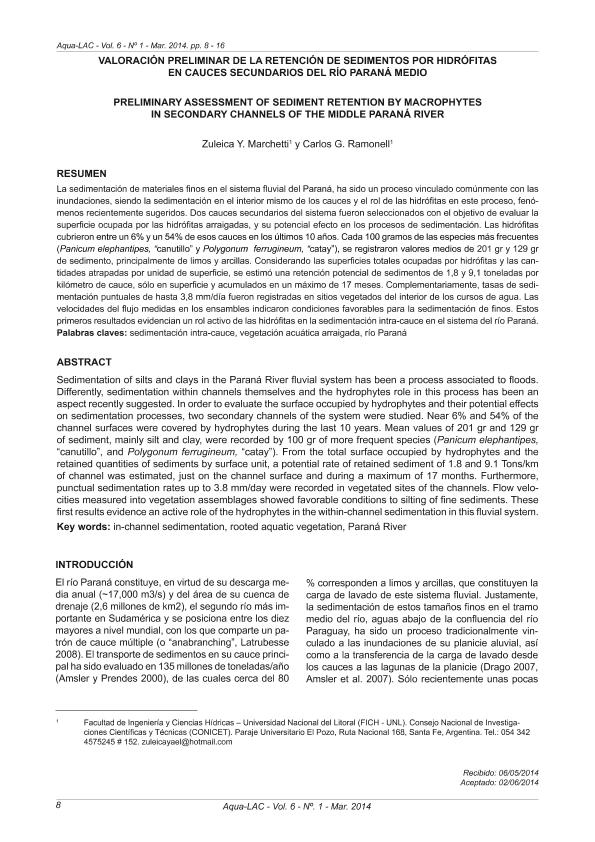Artículo
La sedimentación de materiales finos en el sistema fluvial del Paraná, ha sido un proceso vinculado comúnmente con las inundaciones, siendo la sedimentación en el interior mismo de los cauces y el rol de las hidrófitas en este proceso, fenó- menos recientemente sugeridos. Dos cauces secundarios del sistema fueron seleccionados con el objetivo de evaluar la superficie ocupada por las hidrófitas arraigadas, y su potencial efecto en los procesos de sedimentación. Las hidrófitas cubrieron entre un 6% y un 54% de esos cauces en los últimos 10 años. Cada 100 gramos de las especies más frecuentes (Panicum elephantipes, “canutillo” y Polygonum ferrugineum, “catay”), se registraron valores medios de 201 gr y 129 gr de sedimento, principalmente de limos y arcillas. Considerando las superficies totales ocupadas por hidrófitas y las cantidades atrapadas por unidad de superficie, se estimó una retención potencial de sedimentos de 1,8 y 9,1 toneladas por kilómetro de cauce, sólo en superficie y acumulados en un máximo de 17 meses. Complementariamente, tasas de sedimentación puntuales de hasta 3,8 mm/día fueron registradas en sitios vegetados del interior de los cursos de agua. Las velocidades del flujo medidas en los ensambles indicaron condiciones favorables para la sedimentación de finos. Estos primeros resultados evidencian un rol activo de las hidrófitas en la sedimentación intra-cauce en el sistema del río Paraná. Palabras claves: sedimentación intra-cauce, vegetación acuática arraigada, río Paraná. Sedimentation of silts and clays in the Paraná River fluvial system has been a process associated to floods. Differently, sedimentation within channels themselves and the hydrophytes role in this process has been an aspect recently suggested. In order to evaluate the surface occupied by hydrophytes and their potential effects on sedimentation processes, two secondary channels of the system were studied. Near 6% and 54% of the channel surfaces were covered by hydrophytes during the last 10 years. Mean values of 201 gr and 129 gr of sediment, mainly silt and clay, were recorded by 100 gr of more frequent species (Panicum elephantipes, “canutillo”, and Polygonum ferrugineum, “catay”). From the total surface occupied by hydrophytes and the retained quantities of sediments by surface unit, a potential rate of retained sediment of 1.8 and 9.1 Tons/km of channel was estimated, just on the channel surface and during a maximum of 17 months. Furthermore, punctual sedimentation rates up to 3.8 mm/day were recorded in vegetated sites of the channels. Flow velocities measured into vegetation assemblages showed favorable conditions to silting of fine sediments. These first results evidence an active role of the hydrophytes in the within-channel sedimentation in this fluvial system.
Valoración preliminar de la retención de sedimentos por hidrófitas en cauces secundarios del Río Paraná Medio
Título:
Preliminary assessment of sediment retention by macrophytes in secondary channels of the Middle Paraná River
Fecha de publicación:
03/2014
Editorial:
Unesco. Programa Hidrológico Internacional para América Latina y el Caribe
Revista:
Aqua-LAC
ISSN:
1688-2873
Idioma:
Español
Tipo de recurso:
Artículo publicado
Clasificación temática:
Resumen
Palabras clave:
Sedimentación Intra-Cauce
,
Vegetación Acuática Arraigada
,
Río Paraná
Archivos asociados
Licencia
Identificadores
Colecciones
Articulos(CCT - SANTA FE)
Articulos de CTRO.CIENTIFICO TECNOL.CONICET - SANTA FE
Articulos de CTRO.CIENTIFICO TECNOL.CONICET - SANTA FE
Citación
Ramonell, Carlos Guillermo; Marchetti, Zuleica Yael; Valoración preliminar de la retención de sedimentos por hidrófitas en cauces secundarios del Río Paraná Medio; Unesco. Programa Hidrológico Internacional para América Latina y el Caribe; Aqua-LAC; 6; 1; 3-2014; 8-16
Compartir




